Cultural Dimensions in China: An Analysis using Hofstede's Theory
VerifiedAdded on 2022/11/13
|9
|1275
|293
AI Summary
This report analyzes the various aspects of cultural diversity present in China using Hofstede's theory of Cultural Dimensions. It also evaluates the importance of human resource management with respect to cultural diversity.
Contribute Materials
Your contribution can guide someone’s learning journey. Share your
documents today.
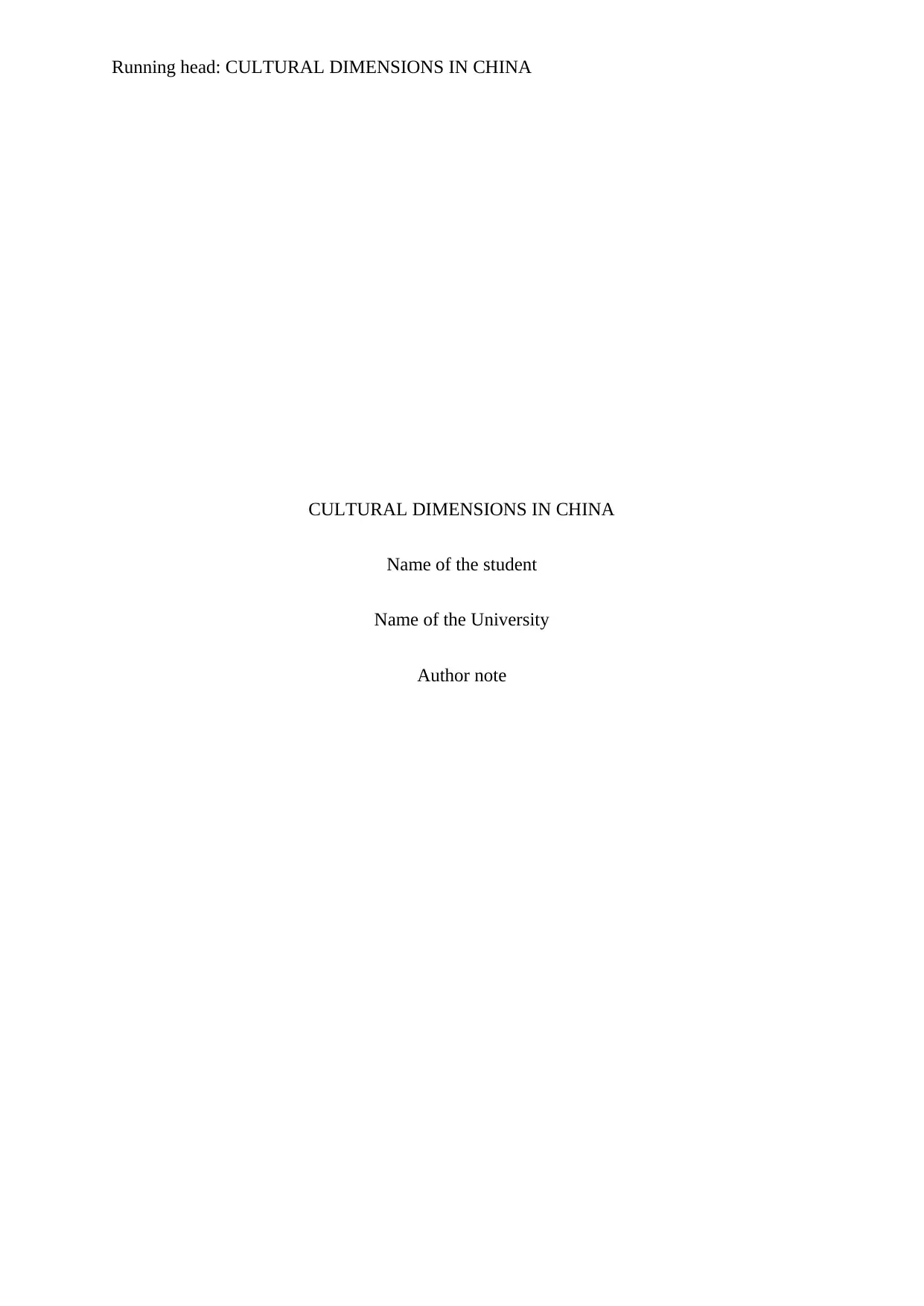
Running head: CULTURAL DIMENSIONS IN CHINA
CULTURAL DIMENSIONS IN CHINA
Name of the student
Name of the University
Author note
CULTURAL DIMENSIONS IN CHINA
Name of the student
Name of the University
Author note
Secure Best Marks with AI Grader
Need help grading? Try our AI Grader for instant feedback on your assignments.
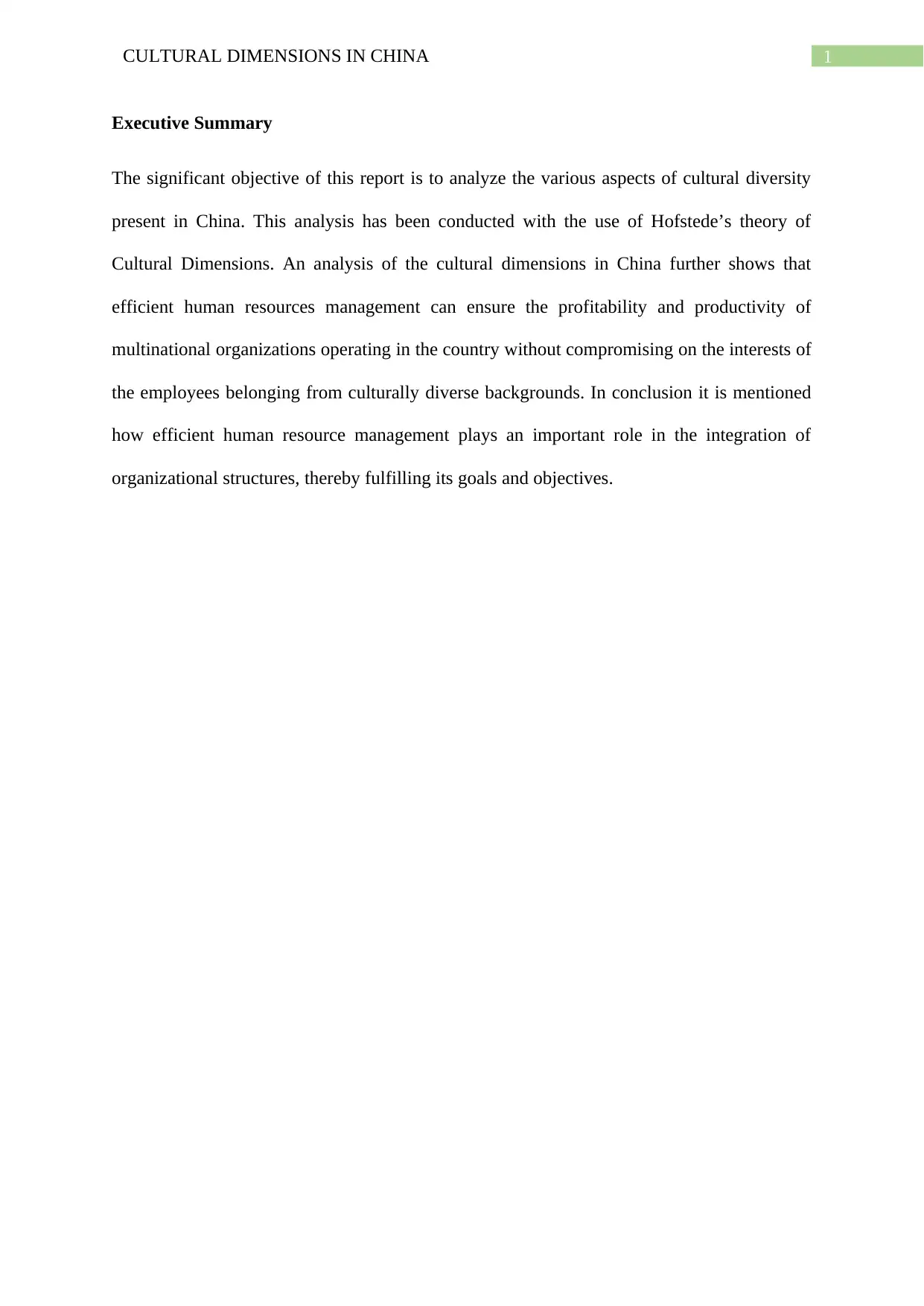
1CULTURAL DIMENSIONS IN CHINA
Executive Summary
The significant objective of this report is to analyze the various aspects of cultural diversity
present in China. This analysis has been conducted with the use of Hofstede’s theory of
Cultural Dimensions. An analysis of the cultural dimensions in China further shows that
efficient human resources management can ensure the profitability and productivity of
multinational organizations operating in the country without compromising on the interests of
the employees belonging from culturally diverse backgrounds. In conclusion it is mentioned
how efficient human resource management plays an important role in the integration of
organizational structures, thereby fulfilling its goals and objectives.
Executive Summary
The significant objective of this report is to analyze the various aspects of cultural diversity
present in China. This analysis has been conducted with the use of Hofstede’s theory of
Cultural Dimensions. An analysis of the cultural dimensions in China further shows that
efficient human resources management can ensure the profitability and productivity of
multinational organizations operating in the country without compromising on the interests of
the employees belonging from culturally diverse backgrounds. In conclusion it is mentioned
how efficient human resource management plays an important role in the integration of
organizational structures, thereby fulfilling its goals and objectives.
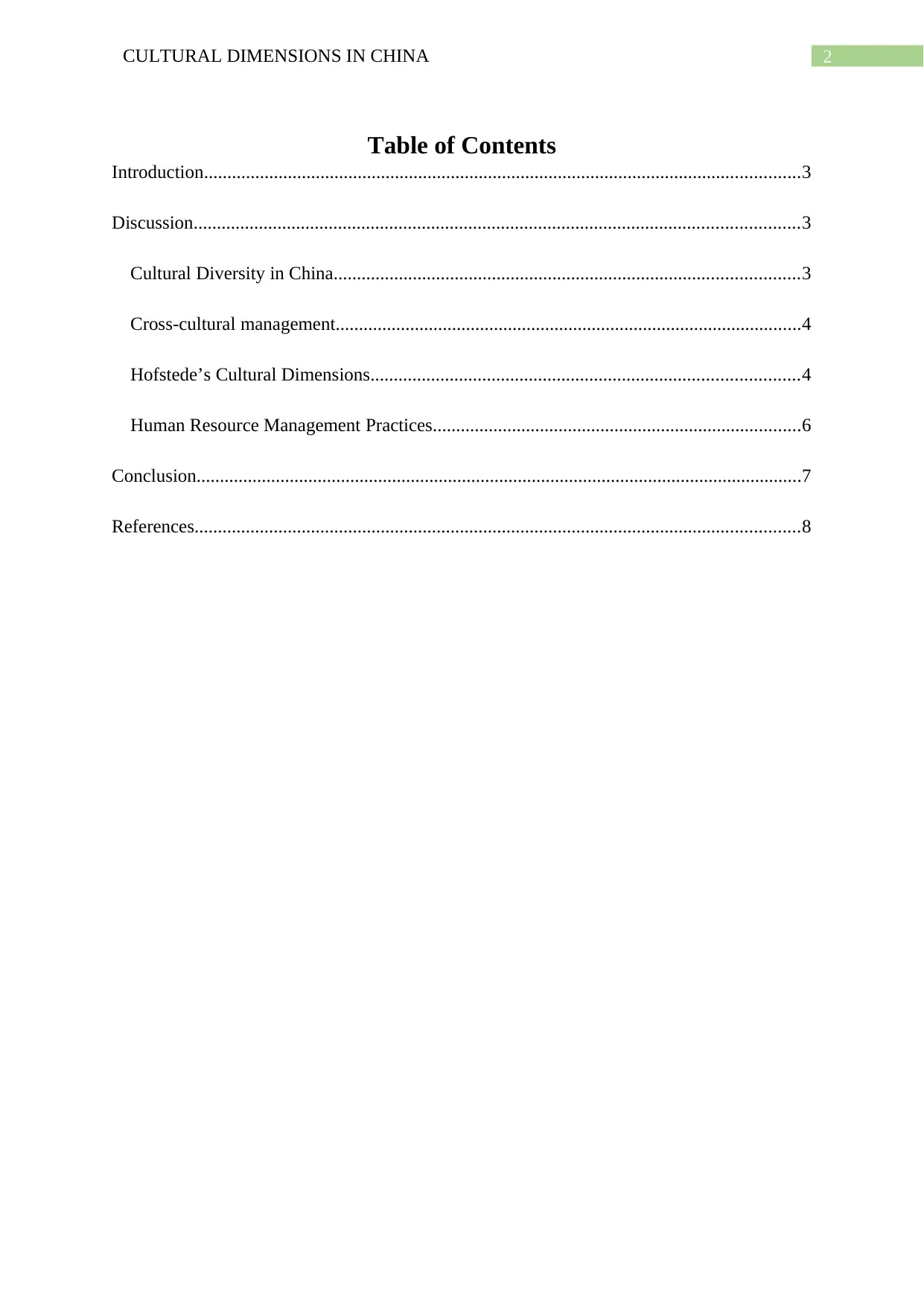
2CULTURAL DIMENSIONS IN CHINA
Table of Contents
Introduction................................................................................................................................3
Discussion..................................................................................................................................3
Cultural Diversity in China....................................................................................................3
Cross-cultural management....................................................................................................4
Hofstede’s Cultural Dimensions............................................................................................4
Human Resource Management Practices...............................................................................6
Conclusion..................................................................................................................................7
References..................................................................................................................................8
Table of Contents
Introduction................................................................................................................................3
Discussion..................................................................................................................................3
Cultural Diversity in China....................................................................................................3
Cross-cultural management....................................................................................................4
Hofstede’s Cultural Dimensions............................................................................................4
Human Resource Management Practices...............................................................................6
Conclusion..................................................................................................................................7
References..................................................................................................................................8
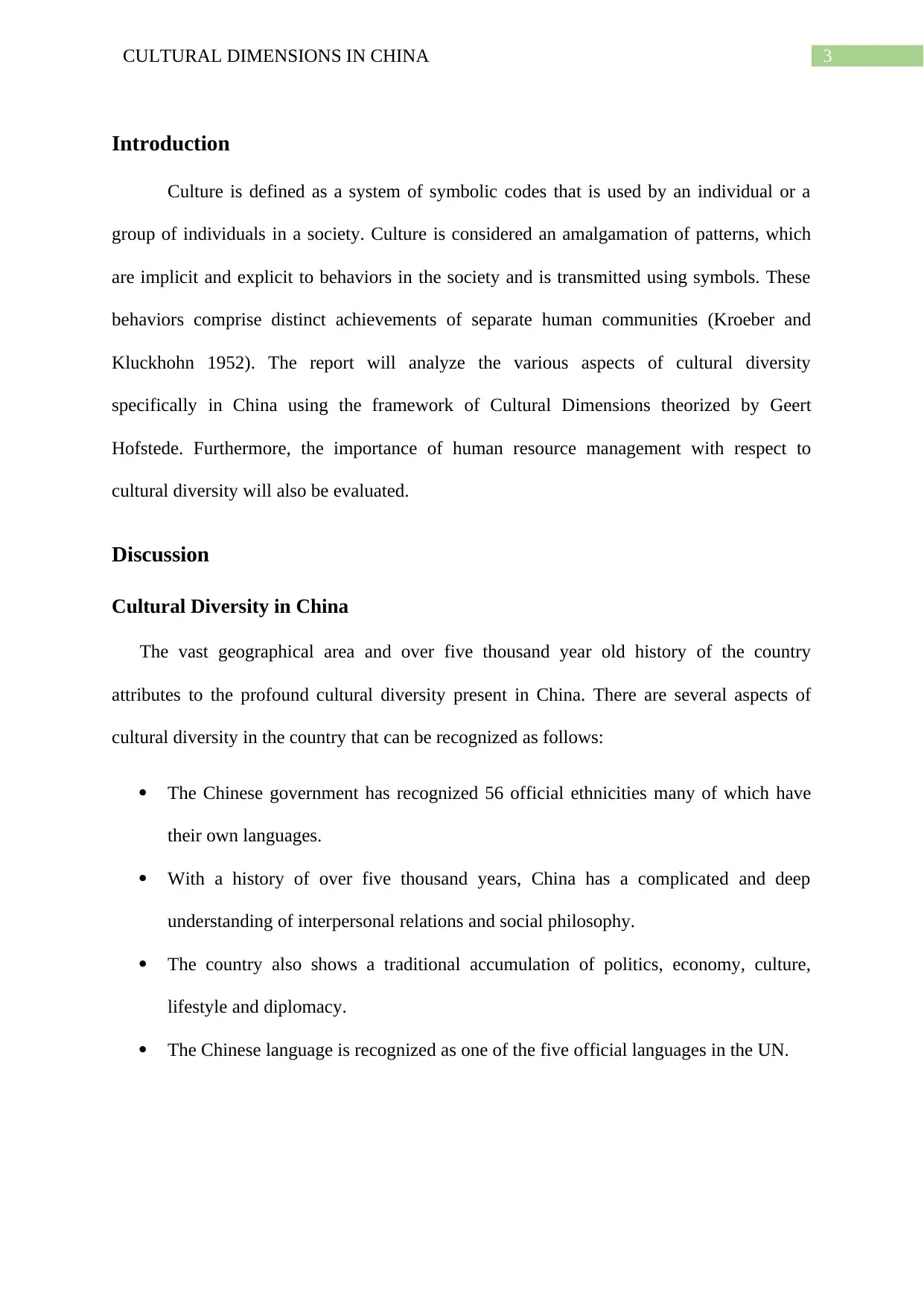
3CULTURAL DIMENSIONS IN CHINA
Introduction
Culture is defined as a system of symbolic codes that is used by an individual or a
group of individuals in a society. Culture is considered an amalgamation of patterns, which
are implicit and explicit to behaviors in the society and is transmitted using symbols. These
behaviors comprise distinct achievements of separate human communities (Kroeber and
Kluckhohn 1952). The report will analyze the various aspects of cultural diversity
specifically in China using the framework of Cultural Dimensions theorized by Geert
Hofstede. Furthermore, the importance of human resource management with respect to
cultural diversity will also be evaluated.
Discussion
Cultural Diversity in China
The vast geographical area and over five thousand year old history of the country
attributes to the profound cultural diversity present in China. There are several aspects of
cultural diversity in the country that can be recognized as follows:
The Chinese government has recognized 56 official ethnicities many of which have
their own languages.
With a history of over five thousand years, China has a complicated and deep
understanding of interpersonal relations and social philosophy.
The country also shows a traditional accumulation of politics, economy, culture,
lifestyle and diplomacy.
The Chinese language is recognized as one of the five official languages in the UN.
Introduction
Culture is defined as a system of symbolic codes that is used by an individual or a
group of individuals in a society. Culture is considered an amalgamation of patterns, which
are implicit and explicit to behaviors in the society and is transmitted using symbols. These
behaviors comprise distinct achievements of separate human communities (Kroeber and
Kluckhohn 1952). The report will analyze the various aspects of cultural diversity
specifically in China using the framework of Cultural Dimensions theorized by Geert
Hofstede. Furthermore, the importance of human resource management with respect to
cultural diversity will also be evaluated.
Discussion
Cultural Diversity in China
The vast geographical area and over five thousand year old history of the country
attributes to the profound cultural diversity present in China. There are several aspects of
cultural diversity in the country that can be recognized as follows:
The Chinese government has recognized 56 official ethnicities many of which have
their own languages.
With a history of over five thousand years, China has a complicated and deep
understanding of interpersonal relations and social philosophy.
The country also shows a traditional accumulation of politics, economy, culture,
lifestyle and diplomacy.
The Chinese language is recognized as one of the five official languages in the UN.
Secure Best Marks with AI Grader
Need help grading? Try our AI Grader for instant feedback on your assignments.
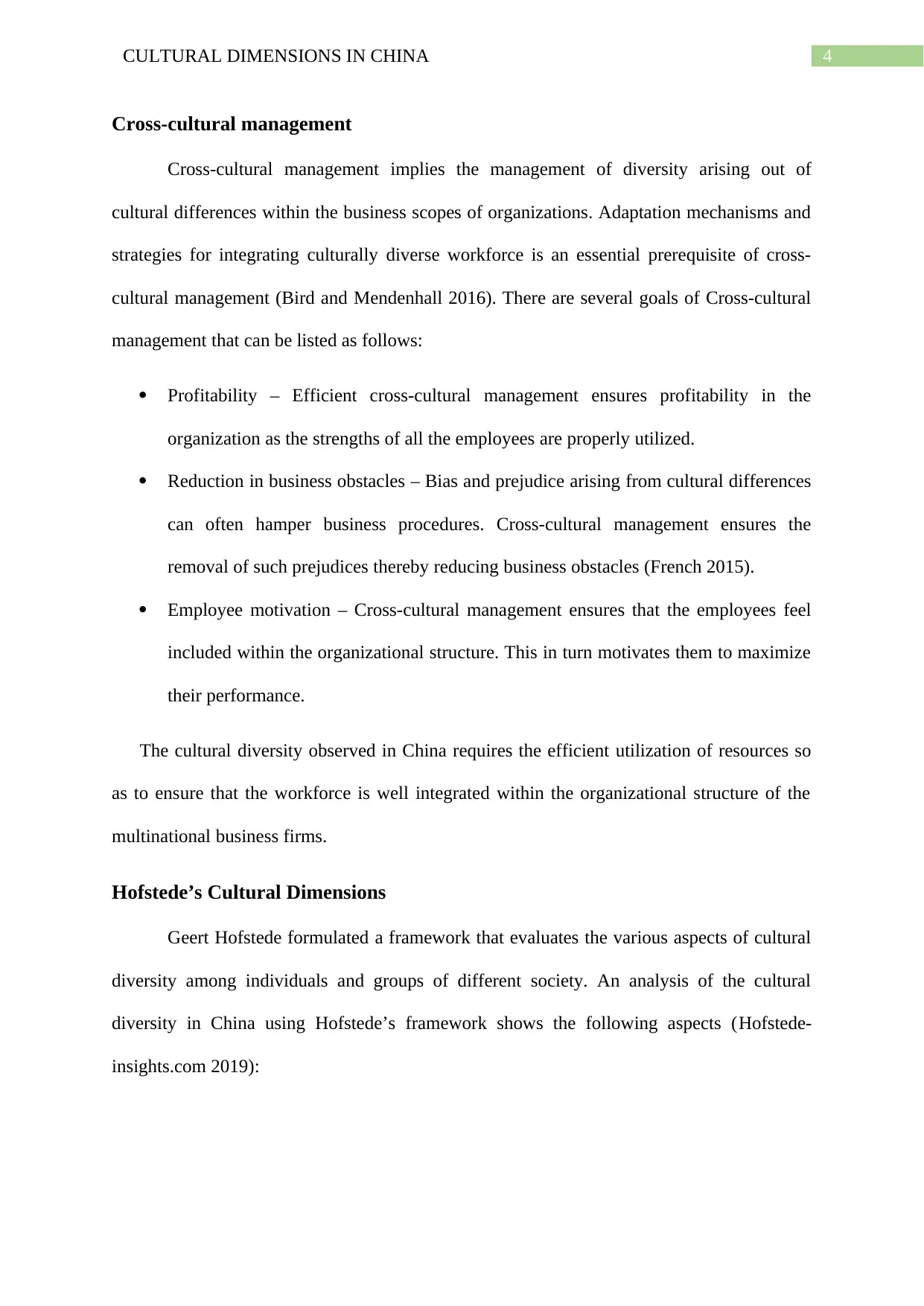
4CULTURAL DIMENSIONS IN CHINA
Cross-cultural management
Cross-cultural management implies the management of diversity arising out of
cultural differences within the business scopes of organizations. Adaptation mechanisms and
strategies for integrating culturally diverse workforce is an essential prerequisite of cross-
cultural management (Bird and Mendenhall 2016). There are several goals of Cross-cultural
management that can be listed as follows:
Profitability – Efficient cross-cultural management ensures profitability in the
organization as the strengths of all the employees are properly utilized.
Reduction in business obstacles – Bias and prejudice arising from cultural differences
can often hamper business procedures. Cross-cultural management ensures the
removal of such prejudices thereby reducing business obstacles (French 2015).
Employee motivation – Cross-cultural management ensures that the employees feel
included within the organizational structure. This in turn motivates them to maximize
their performance.
The cultural diversity observed in China requires the efficient utilization of resources so
as to ensure that the workforce is well integrated within the organizational structure of the
multinational business firms.
Hofstede’s Cultural Dimensions
Geert Hofstede formulated a framework that evaluates the various aspects of cultural
diversity among individuals and groups of different society. An analysis of the cultural
diversity in China using Hofstede’s framework shows the following aspects (Hofstede-
insights.com 2019):
Cross-cultural management
Cross-cultural management implies the management of diversity arising out of
cultural differences within the business scopes of organizations. Adaptation mechanisms and
strategies for integrating culturally diverse workforce is an essential prerequisite of cross-
cultural management (Bird and Mendenhall 2016). There are several goals of Cross-cultural
management that can be listed as follows:
Profitability – Efficient cross-cultural management ensures profitability in the
organization as the strengths of all the employees are properly utilized.
Reduction in business obstacles – Bias and prejudice arising from cultural differences
can often hamper business procedures. Cross-cultural management ensures the
removal of such prejudices thereby reducing business obstacles (French 2015).
Employee motivation – Cross-cultural management ensures that the employees feel
included within the organizational structure. This in turn motivates them to maximize
their performance.
The cultural diversity observed in China requires the efficient utilization of resources so
as to ensure that the workforce is well integrated within the organizational structure of the
multinational business firms.
Hofstede’s Cultural Dimensions
Geert Hofstede formulated a framework that evaluates the various aspects of cultural
diversity among individuals and groups of different society. An analysis of the cultural
diversity in China using Hofstede’s framework shows the following aspects (Hofstede-
insights.com 2019):
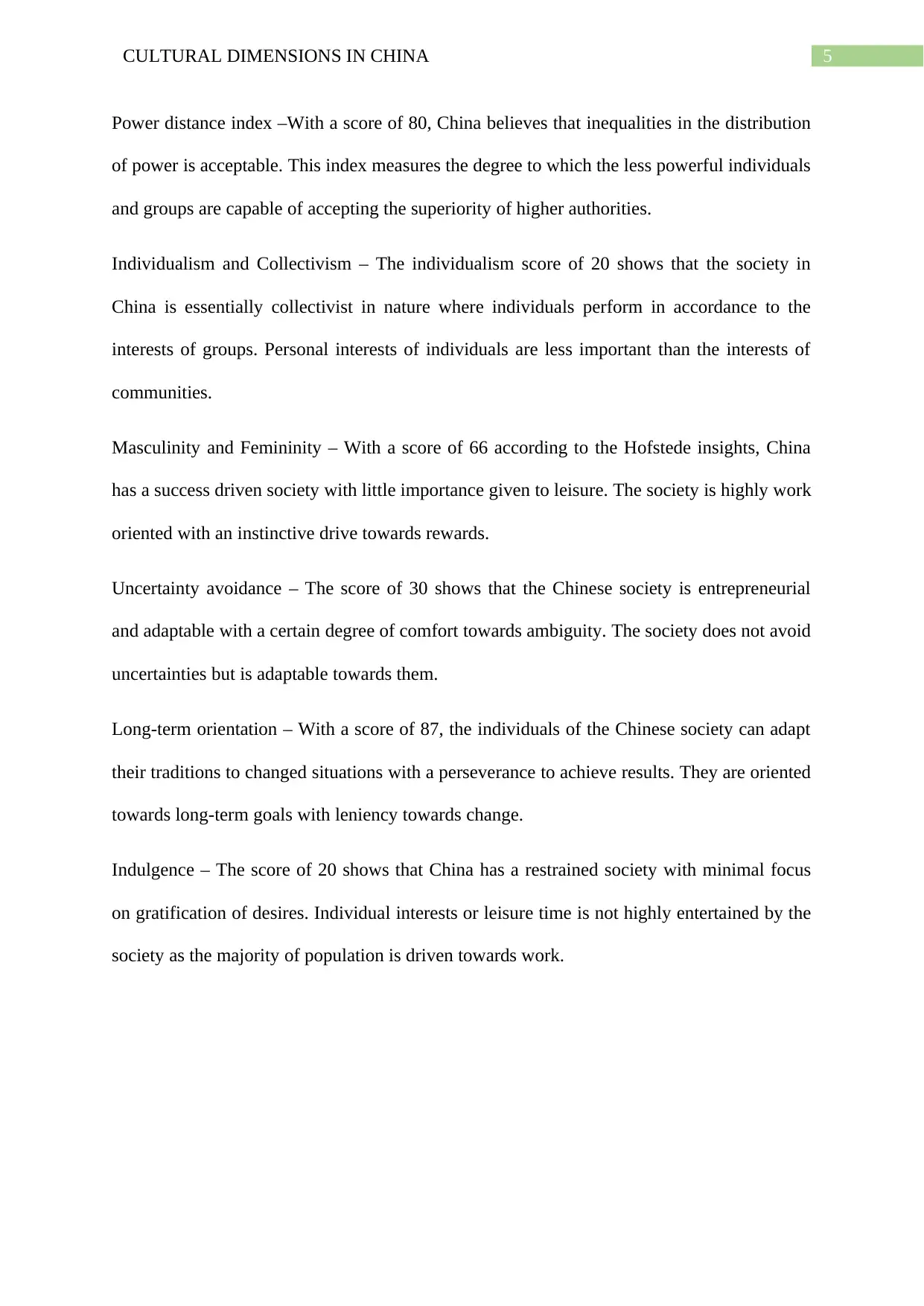
5CULTURAL DIMENSIONS IN CHINA
Power distance index –With a score of 80, China believes that inequalities in the distribution
of power is acceptable. This index measures the degree to which the less powerful individuals
and groups are capable of accepting the superiority of higher authorities.
Individualism and Collectivism – The individualism score of 20 shows that the society in
China is essentially collectivist in nature where individuals perform in accordance to the
interests of groups. Personal interests of individuals are less important than the interests of
communities.
Masculinity and Femininity – With a score of 66 according to the Hofstede insights, China
has a success driven society with little importance given to leisure. The society is highly work
oriented with an instinctive drive towards rewards.
Uncertainty avoidance – The score of 30 shows that the Chinese society is entrepreneurial
and adaptable with a certain degree of comfort towards ambiguity. The society does not avoid
uncertainties but is adaptable towards them.
Long-term orientation – With a score of 87, the individuals of the Chinese society can adapt
their traditions to changed situations with a perseverance to achieve results. They are oriented
towards long-term goals with leniency towards change.
Indulgence – The score of 20 shows that China has a restrained society with minimal focus
on gratification of desires. Individual interests or leisure time is not highly entertained by the
society as the majority of population is driven towards work.
Power distance index –With a score of 80, China believes that inequalities in the distribution
of power is acceptable. This index measures the degree to which the less powerful individuals
and groups are capable of accepting the superiority of higher authorities.
Individualism and Collectivism – The individualism score of 20 shows that the society in
China is essentially collectivist in nature where individuals perform in accordance to the
interests of groups. Personal interests of individuals are less important than the interests of
communities.
Masculinity and Femininity – With a score of 66 according to the Hofstede insights, China
has a success driven society with little importance given to leisure. The society is highly work
oriented with an instinctive drive towards rewards.
Uncertainty avoidance – The score of 30 shows that the Chinese society is entrepreneurial
and adaptable with a certain degree of comfort towards ambiguity. The society does not avoid
uncertainties but is adaptable towards them.
Long-term orientation – With a score of 87, the individuals of the Chinese society can adapt
their traditions to changed situations with a perseverance to achieve results. They are oriented
towards long-term goals with leniency towards change.
Indulgence – The score of 20 shows that China has a restrained society with minimal focus
on gratification of desires. Individual interests or leisure time is not highly entertained by the
society as the majority of population is driven towards work.
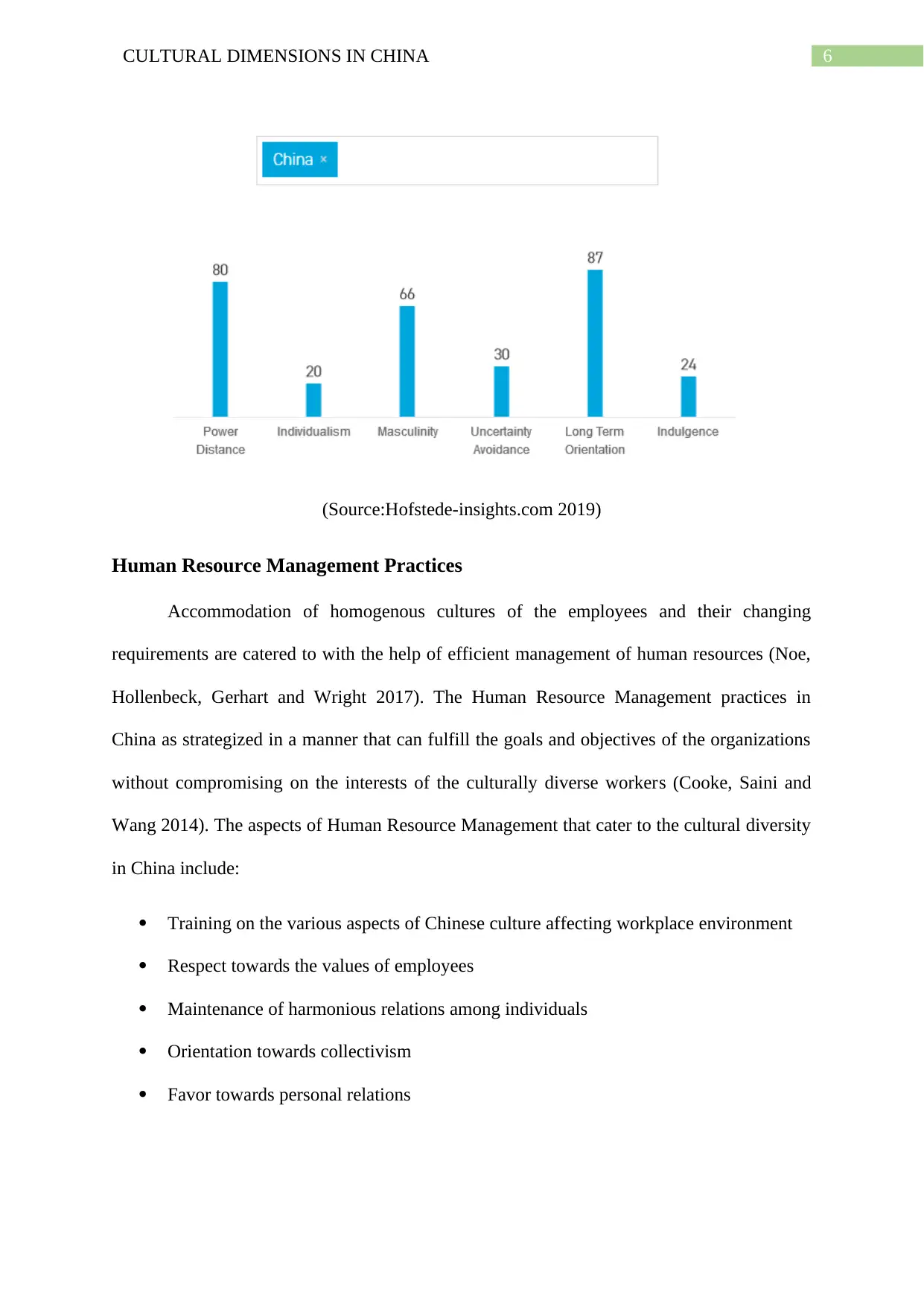
6CULTURAL DIMENSIONS IN CHINA
(Source:Hofstede-insights.com 2019)
Human Resource Management Practices
Accommodation of homogenous cultures of the employees and their changing
requirements are catered to with the help of efficient management of human resources (Noe,
Hollenbeck, Gerhart and Wright 2017). The Human Resource Management practices in
China as strategized in a manner that can fulfill the goals and objectives of the organizations
without compromising on the interests of the culturally diverse workers (Cooke, Saini and
Wang 2014). The aspects of Human Resource Management that cater to the cultural diversity
in China include:
Training on the various aspects of Chinese culture affecting workplace environment
Respect towards the values of employees
Maintenance of harmonious relations among individuals
Orientation towards collectivism
Favor towards personal relations
(Source:Hofstede-insights.com 2019)
Human Resource Management Practices
Accommodation of homogenous cultures of the employees and their changing
requirements are catered to with the help of efficient management of human resources (Noe,
Hollenbeck, Gerhart and Wright 2017). The Human Resource Management practices in
China as strategized in a manner that can fulfill the goals and objectives of the organizations
without compromising on the interests of the culturally diverse workers (Cooke, Saini and
Wang 2014). The aspects of Human Resource Management that cater to the cultural diversity
in China include:
Training on the various aspects of Chinese culture affecting workplace environment
Respect towards the values of employees
Maintenance of harmonious relations among individuals
Orientation towards collectivism
Favor towards personal relations
Paraphrase This Document
Need a fresh take? Get an instant paraphrase of this document with our AI Paraphraser
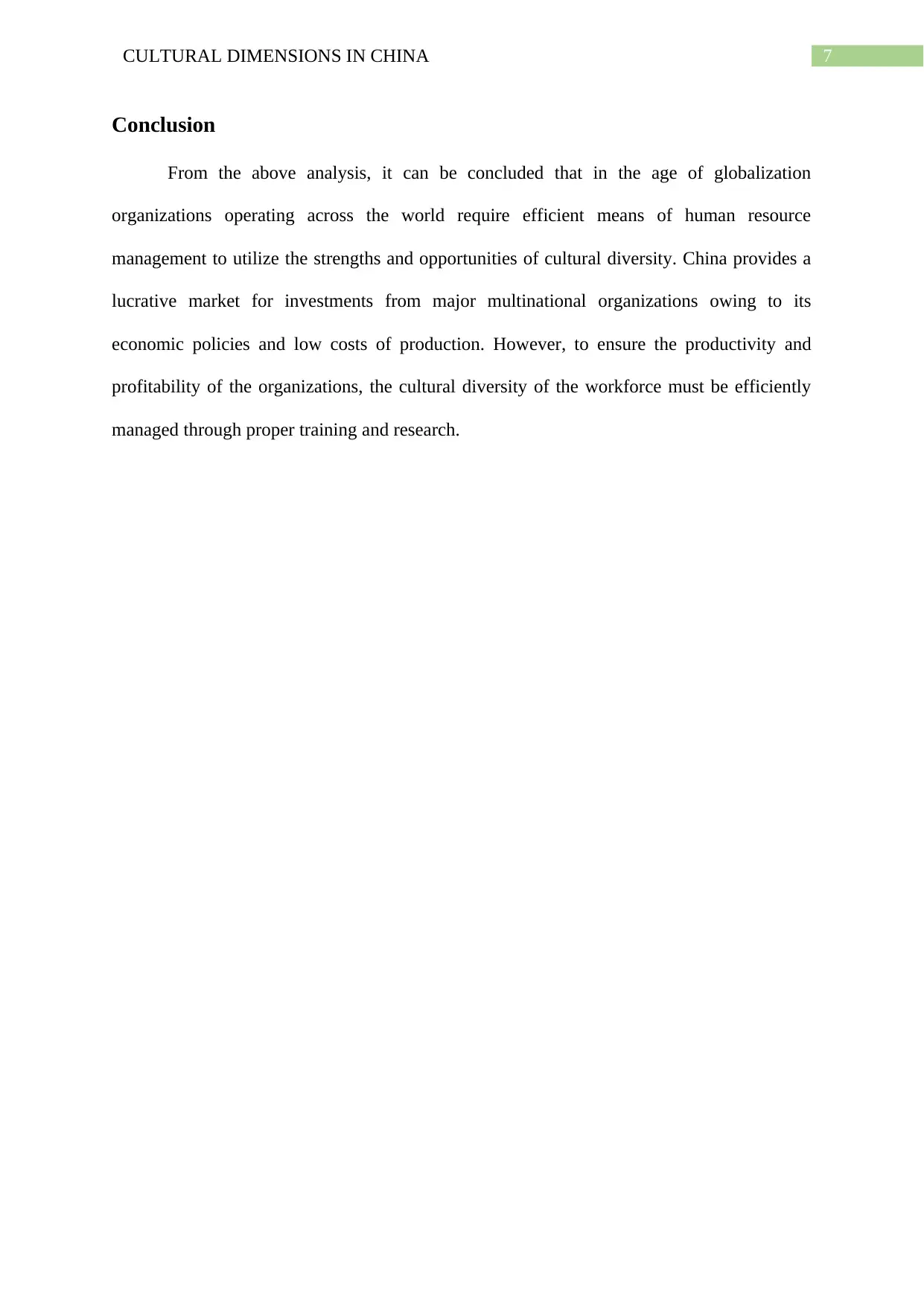
7CULTURAL DIMENSIONS IN CHINA
Conclusion
From the above analysis, it can be concluded that in the age of globalization
organizations operating across the world require efficient means of human resource
management to utilize the strengths and opportunities of cultural diversity. China provides a
lucrative market for investments from major multinational organizations owing to its
economic policies and low costs of production. However, to ensure the productivity and
profitability of the organizations, the cultural diversity of the workforce must be efficiently
managed through proper training and research.
Conclusion
From the above analysis, it can be concluded that in the age of globalization
organizations operating across the world require efficient means of human resource
management to utilize the strengths and opportunities of cultural diversity. China provides a
lucrative market for investments from major multinational organizations owing to its
economic policies and low costs of production. However, to ensure the productivity and
profitability of the organizations, the cultural diversity of the workforce must be efficiently
managed through proper training and research.
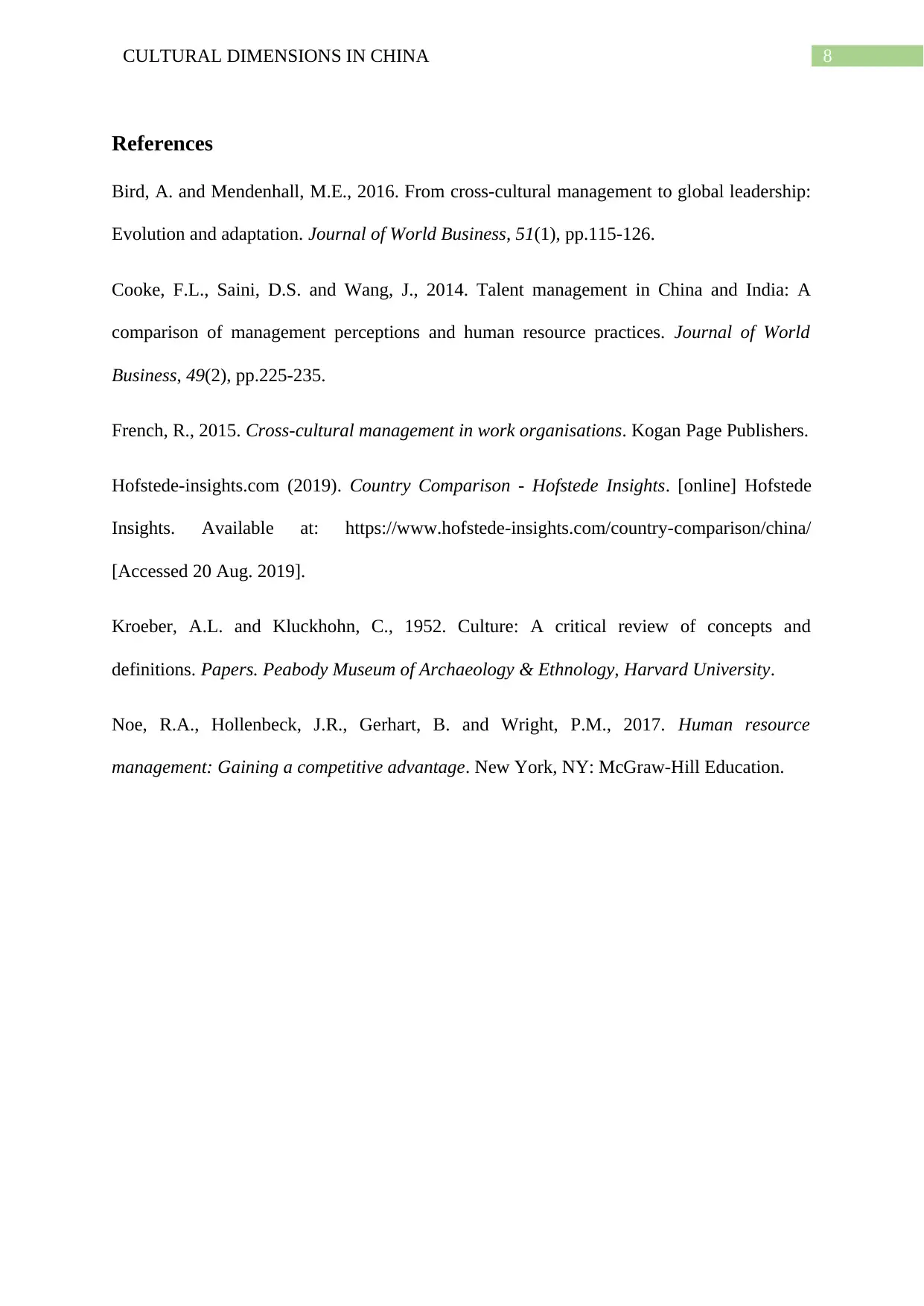
8CULTURAL DIMENSIONS IN CHINA
References
Bird, A. and Mendenhall, M.E., 2016. From cross-cultural management to global leadership:
Evolution and adaptation. Journal of World Business, 51(1), pp.115-126.
Cooke, F.L., Saini, D.S. and Wang, J., 2014. Talent management in China and India: A
comparison of management perceptions and human resource practices. Journal of World
Business, 49(2), pp.225-235.
French, R., 2015. Cross-cultural management in work organisations. Kogan Page Publishers.
Hofstede-insights.com (2019). Country Comparison - Hofstede Insights. [online] Hofstede
Insights. Available at: https://www.hofstede-insights.com/country-comparison/china/
[Accessed 20 Aug. 2019].
Kroeber, A.L. and Kluckhohn, C., 1952. Culture: A critical review of concepts and
definitions. Papers. Peabody Museum of Archaeology & Ethnology, Harvard University.
Noe, R.A., Hollenbeck, J.R., Gerhart, B. and Wright, P.M., 2017. Human resource
management: Gaining a competitive advantage. New York, NY: McGraw-Hill Education.
References
Bird, A. and Mendenhall, M.E., 2016. From cross-cultural management to global leadership:
Evolution and adaptation. Journal of World Business, 51(1), pp.115-126.
Cooke, F.L., Saini, D.S. and Wang, J., 2014. Talent management in China and India: A
comparison of management perceptions and human resource practices. Journal of World
Business, 49(2), pp.225-235.
French, R., 2015. Cross-cultural management in work organisations. Kogan Page Publishers.
Hofstede-insights.com (2019). Country Comparison - Hofstede Insights. [online] Hofstede
Insights. Available at: https://www.hofstede-insights.com/country-comparison/china/
[Accessed 20 Aug. 2019].
Kroeber, A.L. and Kluckhohn, C., 1952. Culture: A critical review of concepts and
definitions. Papers. Peabody Museum of Archaeology & Ethnology, Harvard University.
Noe, R.A., Hollenbeck, J.R., Gerhart, B. and Wright, P.M., 2017. Human resource
management: Gaining a competitive advantage. New York, NY: McGraw-Hill Education.
1 out of 9
Related Documents
Your All-in-One AI-Powered Toolkit for Academic Success.
+13062052269
info@desklib.com
Available 24*7 on WhatsApp / Email
![[object Object]](/_next/static/media/star-bottom.7253800d.svg)
Unlock your academic potential
© 2024 | Zucol Services PVT LTD | All rights reserved.





